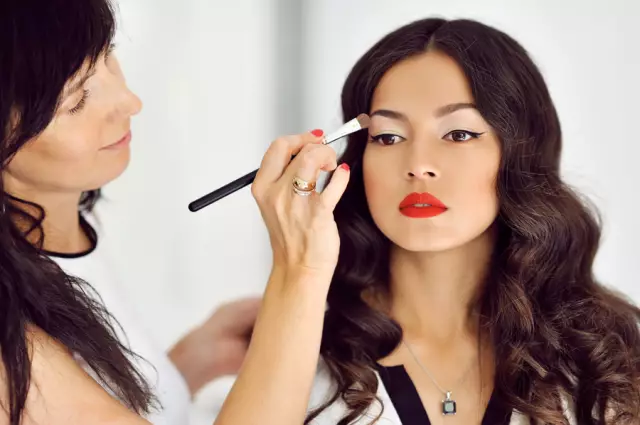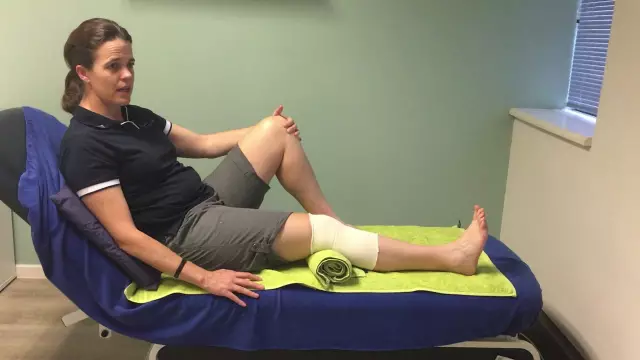- Author Rachel Wainwright [email protected].
- Public 2023-12-15 07:39.
- Last modified 2025-11-02 20:14.
What perfumes and cosmetics can be dangerous?
Every woman has her own preferences in terms of products that help her look good, feel young and effective. Even the very process of choosing a perfume, shampoo or decorative cosmetics is already uplifting and serves as a kind of stress reliever. And it can be very offensive when the purchased perfumery and cosmetic products not only do not meet expectations, but also cause health problems. We will consider the sources of this kind of trouble and how to avoid them today.

Source: depositphotos.com
Harmful substances contained in "beauty products"
Each perfumery and cosmetic product has a specific set of consumer qualities. For example, shampoo should foam well and effectively cleanse hair, lipstick should have a beautiful color and consistency that allows it to stay on the surface of the lips for a long time, perfume should have a strong and persistent scent. It is impossible to achieve such properties without the addition of various synthetic chemicals. Many of the ingredients in modern "beauty products" are far from safe. The list of the most harmful of them includes:
- alkylphenol ethoxylate. A component of most shampoos. Possesses mutagenic and carcinogenic properties. Inhibits the process of sperm production in men;
- albumen. It is found in anti-aging creams as a wrinkle-reducing agent. In fact, it creates a dense film that restricts the access of oxygen, which interferes with the normal course of metabolic processes in the skin;
- alpha hydroxy acids. Ingredients for most face and body scrubs. They help to exfoliate dead cells, but make the skin defenseless against aggressive environmental factors;
- acetamide. A moisturizer in blush and lipstick. Mutagen, carcinogen;
- benzene. It is included in many cosmetic products. Extremely toxic;
- butylhydroxyanisole. A preservative used to increase the shelf life of products (creams, sprays, etc.). Possesses carcinogenic properties, is quickly absorbed through the skin and accumulates in the body;
- gamma hexachlorane. Component of many shampoos, creams, lotions. Has a toxic effect on the nervous system. May provoke the development of skin cancer;
- dioxane. Part of soaps, shampoos, lotions, creams, hair conditioners. It is a strong carcinogen. Has a destructive effect on liver cells;
- isopropanol. Component in mouth washes and other products. Able to cause severe poisoning, accompanied by dizziness, headache and nosebleeds. With prolonged use, it causes the development of malignant neoplasms of the throat and oral cavity;
- imidazolidinyl urea. A very common preservative. Included in eye shadows, powders, shampoos (including baby shampoos), colognes and lotions. Provokes the appearance of dermatitis. When stored in heat, decomposes, releasing formaldehyde;
- coal tar (tar). One of the main ingredients in anti-dandruff shampoos. May cause asthma attacks and other allergic reactions. Long-term use leads to a decrease in attention and memory, chronic fatigue, headaches, nausea;
- carbomer. Stabilizer and thickener in mascaras, creams, bath products. Provokes the development of inflammatory processes of the eyes and skin allergic reactions;
- quaternium-15. Antimicrobial agent and preservative. After the expiration of the shelf life, decomposes with the release of formaldehyde;
- cocamide DEA (coconut oil amide). A popular component in shampoos. A complex substance that can decompose with the formation of highly carcinogenic nitrosamines;
- sodium laureth sulfate (SLES). It is part of the vast majority of shampoos. It is not very effective as a detergent, but it is cheap and lathers well, giving the illusion of a high quality product. Extremely harmful. Dries hair and scalp, inhibits hair growth, destroys hair follicles. Poorly excreted from the body, accumulates in the liver, brain, eye tissues. Negatively affects vision. No less dangerous substances with similar properties are ammonium laureth sulfate (ALS) and sodium lauryl sulfate (SLS), which are also widely used in the production of shampoos and bath foam;
- loramide day (DEA). Another foaming agent in soaps and shampoos. Easily enters into chemical reactions leading to the release of nitrosamines;
- methylchloroisothiazolinone. A preservative with carcinogenic and mutagenic properties;
- para-aminobenzoic acid (vitamin B10). A frequent ingredient in sunscreens. Phototoxic. May provoke the appearance of eczema and contact dermatitis;
- parabens. The name of a group of commonly used preservatives. Strong allergens. Cause breast cancer;
- para-phenylenediamines. Substances that color the hair black or brown. They provoke the appearance of various malignant neoplasms (lymphomas, myelomas, etc.);
- polysorbates. Emulsifiers. Toxic. Application is fraught with dermatitis;
- propylene glycol. Cheap product of the distillation of oil. It is found in many shampoos and skin care products as a moisturizer. In fact, it strongly dries and irritates the skin and accumulates in the body, having a negative effect on the functioning of the kidneys and liver;
- triclosan. A popular antibacterial ingredient in detergents. Carcinogenic and toxic. It has a bad effect on the state of the brain, lungs, liver and kidneys, reduces potency;
- FDS ((FDC-n or FD&C). A group of substances used as dyes. Most of them irritate the skin, and some are carcinogenic. In small quantities they are safe, but the acceptable concentrations for each color group are not clearly defined, and the risk of overdose is very high;
- phthalates (phthalic acid salts). Components of many perfumery and cosmetic products. Highly toxic. Destroy liver and kidney cells. If ingested, a pregnant woman can cause fetal malformations;
- fluorocarbons. Part of hair sprays. In aerosol form, they are dangerous for the respiratory system;
- formaldehyde. Preservative, a component of soap, shampoo, decorative cosmetics. Irritating to skin and mucous membranes. Carcinogen;
- ethanolamines. A large group of substances that are added to soaps, shampoos, bath foams as foaming agents and emulsifiers. May have toxic effects on the skin, bone and spinal cord, liver and kidneys.

Source: depositphotos.com
Separately, it is worth dwelling on the substances that cosmetics manufacturers advertise as products that can improve the condition of the skin and even rejuvenate it. These are elastin and collagen, which are produced from the tissues of cattle or poultry. Unfortunately, as ingredients in cosmetics, they are more harmful than beneficial. The fact is that elastin and collagen, which give elasticity to human skin, are very different from their counterparts of animal origin. The molecules of the latter are too large to be compatible with human skin. The products containing them simply create a surface film that prevents the skin from breathing, but do not have any cosmetic effect. The highly advertised lanolin (animal wax) also does not penetrate the skin. But it clogs pores and can cause allergic reactions.
Choosing cosmetics and perfumery wisely
The risk associated with the use of perfumes and cosmetics is not limited to the possible ingestion of toxic substances. On the packaging of goods produced by well-known companies, there is reliable information about the composition and shelf life. However, today in Russia there is a lot of "counterfeit" (imitating the products of well-known brands), as well as means of completely unknown brands. When buying such products, the risk of getting at least an allergic reaction in addition increases dramatically. Therefore, when choosing perfumes and cosmetics, you must keep in mind the following:
- you cannot buy "beauty products" anywhere. It is clear that when we go shopping of this kind in well-known shops and salons, we agree in advance to some overpayment. But health is worth it. This is the only way to minimize the risk of acquiring a dangerous product;
- you need to carefully read everything that is written on the product packaging. It is especially important to pay attention to its expiration date and composition. Many hazardous ingredients have several names, and manufacturers often put the least-known of them on the packaging. Therefore, it is a good idea to have a list of unwanted components with you with all the variations of their names;
- do not buy expensive perfumery and cosmetic products in a hurry. They require thoughtful approach and careful examination of samples. Even a company store can sell perfumes (by the way, they are most often counterfeited) or decorative cosmetics, very similar to the products of famous companies, but still being "counterfeit". It makes sense to find out in advance about all the packaging features of these products and have an accurate description with you;
- it is dangerous to change your preferences for "beauty products" often. It is better to choose the products of one or two reputable companies and buy them in stores that are trustworthy.

Source: depositphotos.com
It is very important to observe the rules and terms of storage of perfumery and cosmetic products. Many of them become dangerous due to the fact that the components decompose in the heat with the formation of toxic substances. In others, during long-term storage, an environment is created that is favorable for the reproduction of pathogens. On the packaging of products of famous brands, there is usually information about how long it will be safe to use the product after opening the jar or tube. Such data should not be neglected.
Recently, women often give preference to "beauty products" made on their own or purchased from hand-made masters. Here, an essential role is played by the absence (or presence) of allergies (most of these products consist of natural ingredients) and the degree of trust in the manufacturer. However, the use of piece goods in any case provides an individual approach to the selection of components and minimization of the risks associated with the inclusion of potentially hazardous substances in the composition of cosmetics and perfumes.
YouTube video related to the article:

Maria Kulkes Medical journalist About the author
Education: First Moscow State Medical University named after I. M. Sechenov, specialty "General Medicine".
Found a mistake in the text? Select it and press Ctrl + Enter.






